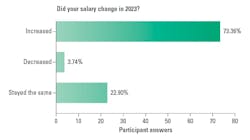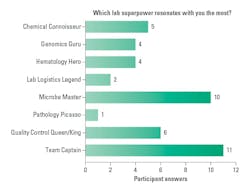The results of Medical Laboratory Observer’s 2024 annual survey of laboratory professionals reveal salaries have increased for most individuals surveyed (73%), more than one-third (33%) received bonuses as part of their 2023 compensation, and employer benefits offerings remain robust in major categories (health/dental/vision insurance, 401k/pension plan, etc.).
Regarding challenges facing the profession, staffing shortages persist, although reported not to be as severe as last year. Automation is a growing area of opportunity, with more lab professionals reporting their labs having automated or further automated new procedures.
For this article, MLO also reached out to the medical laboratory community to gather commentary on the state of the field and what is needed to better support lab professionals, which we present alongside the quantitative survey results data.
A look at the respondents
Most of the 220 lab professionals taking part in the survey this year are female (72%), 46–65 years old (60%) and work in hospital laboratories (64%).
We will make comparisons between the 2024 and 2023 survey results, but it is interesting to note there were some distinct changes in respondents’ demographics compared with last year.
Workplaces and job titles
Laboratory professionals who took part in this year’s survey are more diverse in their workplaces compared with those who participated in 2023, with one-third fewer working in hospitals (64% in 2024, down from 94% in 2023), and more employed by independent labs, government/public health labs, medical schools, MedTech/CLS education programs, and “other” facilities.
This year’s respondents were also more varied in their job titles, with fewer in lab director, manager, administrator and supervisor positions (41% in 2024, down from 73% in 2023), and more serving in medical laboratory scientists (MLS/MS) and medical laboratory technicians (MLT) roles (19% in 2024, up from 4% in 2023).
Age and experience
As with last year’s survey results, most lab professionals this year fell into the age range of 46–65 years old (60%), but there was an increase in respondents aged 45 or younger (25% in 2024, up from 18% in 2023), including those aged 26-35 (9% in 2024, up from 4% in 2023).
There were slight fluctuations in other age groups as well, with a slight decrease in individuals aged 55-65 (36% in 2024, down from 40% in 2023) and a slight increase in respondents in the 71+ age range (7% in 2024, up from 4% in 2023).
Regarding experience, nearly half of those surveyed (46%) reported having more than 30 years in the lab industry. Years of experience among the other respondents:
· 25-30 years: 15%
· 20-24 years: 10%
· 15-19 years: 7%
· 10-14 years: 11%
· 6-9 years: 6%
· 3-5 years: 2%
· Less than 3 years: 4%
Lab size
Those surveyed varied in the number of employees working in their labs:
· 1-10 employees: 22%
· 11-20 employees: 11%
· 21-50 employees: 21%
· 51-100 employees: 18%
· More than 100 employees: 22%
Lab professionals in supervisory positions also varied in how many employees they oversee:
· 1-5: 17%
· 6-10: 15%
· 11-15: 9%
· 16-20: 6%
· 21-30: 6%
· More than 30: 12%
· None: 36%
Looking at test volumes, 40% of survey respondents work for labs with annual testing volumes above 1M, with 17% reporting more than 2M tests annually. Respondents with labs across other annual testing volumes are as follows:
· 500,001 - $1M: 11%
· 100,001- 500,000: 19%
· 50,001 – 100,000: 8%
· 25,001 – 50,000: 4%
· Less than 25,000: 7%
· N/A: 11%
Compensation and benefits
More than half (54%) of those surveyed report being salaried (down from 72% in 2023) and 46% hourly (up from 28% in 2023). Looking at annual base salary ranges, most respondents fell in the range of $50,000 and $150,000 (81%), with the highest percentage reporting salaries between $75,000 and $99,999 (37%).
The full range of responses are as follows:
· Over $151,000: 9%
· Between $100,000 and $150,000: 24%
· Between $75,000 and $99,999: 37%
· Between $50,000 and $74,999: 20%
· Between $20,000 and $49,999: 6%
· Less than $20,000: 2%
When asked if their salary changed in 2023, 73% said it increased (down from 76% in 2023), 4% said it decreased (up from 2% in 2023), and 23% said it stayed the same (up from 22% in 2023). Looking ahead to salary increases in 2024, more than half (53%) said they expect a 2-4% pay raise, which was a similar percentage rate to last year (54% in 2023).
Among the remaining respondents:
· Expect a greater than 10% increase: 3%
· Expect an 8-10% increase: 3%
· Expect a 5-7% increase: 10%
· Expect less than a 2% increase: 13%
· Expect no increase: 7%
· Do not know: 10%
The percentage of lab professionals receiving bonuses as part of their 2023 compensation was 33%, while 67% said they did not receive a bonus last year.
Angela Tomei Robinson, MS, MLS ASCP cm, Laboratory Advocate, commented on the importance of compensation in the medical lab field, stating:
“Qualified professionally recognized board-certified Medical Laboratory Professionals perform quality standards of laboratory testing for patient care and deserve compensation commensurate with education and experience - similarly to other healthcare professionals such as nursing and radiology and pharmacy etc. Besides compensation of salaries, the total package of supportive leadership and resourceful environments need to include benefits and flexibility of scheduling and promotion opportunities.”
Employer benefit offerings remain robust, changing little compared with last year’s survey responses. The most reported benefits among 2024 respondents were health insurance (95%), dental insurance (91%), vision insurance (87%), 401k or pension plan (86%), PTO (81%), life insurance (79%), and disability insurance (77%).
Other reported employer benefits include:
· Paid holidays: 64%
· Employee assistance program: 62%
· Tuition reimbursement: 58%
· Overtime pay: 47%
· Bonuses: 27%
· Flextime: 19%
· Childcare: 7%
Dr. Michael D. Todd, DHSc, MS, MT (ASCP), Director of Laboratory Services, WellStar Douglas Hospital in Douglasville, GA., stressed how organizations must be willing to provide top excellent benefits/incentives along with an adequate salary, stating:
“These benefits/incentives must go beyond medical/dental/vision insurance. Organizations will need to consider providing sign-on bonuses, performance-based rewards, and many opportunities for professional development (paid conferences, CEUs, and tuition reimbursement for furthering their educational endeavors).”
Regarding satisfaction with their lab’s education and training programs, one-quarter of survey respondents (25%) reported being “very satisfied,” 48% “somewhat satisfied,” 17% “somewhat dissatisfied,” and 10% “very dissatisfied.”
Job security, satisfaction, and tenure
More than half of respondents (53%) reported feeling “very secure” (down from 57% in 2023), 39% “somewhat secure” (up from 38% in 2023), 6% “somewhat insecure” (up from 3% in 2023) and 2% “very insecure” (down from 3% in 2023) in their jobs.
Turning to job satisfaction, 14% more lab professionals said they are “very satisfied” with their jobs compared with last year (44% in 2024, up from 30% in 2023). Among the remaining respondents, 44% said they are “somewhat satisfied” (down from 53% in 2023), 9% “somewhat dissatisfied” (down from 14% in 2023), and 3% “very dissatisfied” (same as last year).
This year, more lab professionals surveyed reported less than 3 years with their current employer compared with last year (22% in 2024, up from 9% in 2023), and fewer respondents reported more than 30+ years tenure (13% in 2024, down from 20% in 2023).
The remaining lab professionals reported time with current employer as follows:
· 3-5 years: 13%
· 6-9 years: 11%
· 10-14 years: 13%
· 15-19 years: 10%
· 20-24 years: 9%
· 25-30 years: 8%
Degrees, certifications, and continuing education
Looking at level of education, half of those surveyed (50%) reported holding bachelor’s degrees, 39% post-graduate degrees, 10% associate’s degrees, and 1% said high school was their highest level of education.
When asked what certifications they hold, there were some ups and downs in the percentages compared with the 2023 survey results.
While more than half of survey respondents (63%) reported certification by the American Society for Clinical Pathology, this was down from 78% in 2023. There were also fewer Medical Technology/MT (28% in 2024, down from 44% in 2023) and Clinical Laboratory Scientist/CLS certifications (14% in 2024, down from 21% in 2023). Conversely, more lab professionals reported Medical Laboratory Scientist/MLS/MS certifications (30% in 2024, up from 20% in 2023). The percentages of other certifications remained relatively unchanged year over year.
When asked from which organizations they had received professional certifications, the majority of respondents (75%) selected the American Society for Clinical Pathology (ASCP), which was only slightly lower than last year (78% in 2023). Reported certification from other organizations were similar to last year’s responses.
Turning to continuing education, nearly half of lab professionals surveyed (46%) said they took more than 11 classes last year, with 19% taking more than 20.
Challenges and opportunities
Dr. Todd commented on what seems like a snowball effect in the medical lab field, with one issue compounding the next, stating:
“Laboratory professionals, depending on where they practice their profession, can face a multitude of challenges related to staffing and job satisfaction. The first and most obvious challenge is a shortage of trained, highly skilled lab personnel.”
He noted how many state-funded and private universities “either struggle to maintain high quality medical/clinical laboratory science programs or choose to divert funding to other programs.”
“Several two-year technical and community colleges around the country offer Medical Laboratory Technician (MLT) training programs; however, the four-year, bachelor’s degree level Medical/Clinical Lab Science (MLS) programs are few and very far between,” said Dr. Todd. “Additionally, with an expected major exodus of the current workforce due to aging and retirement over the next five (5) to 10 years, there won’t be enough training programs to keep up with the expected needed number of laboratory professionals to fill these open positions.”
According to Dr. Todd, this leads to the next challenge, which is a high rate of attrition/turnover because the job market is so competitive due to the current staffing shortage. He said with that staffing shortage comes heavier workloads (increased units of service [test volume] per FTE) leading to burn-out and more attrition.
“Couple this with the fact that salaries for laboratory professionals may not be adequate for the level of education and responsibility required for the job and the attrition rate then climbs even higher as staff leave to find higher paying positions at their current level or look to other healthcare systems who have opportunities available for advancement to higher levels of responsibility or leadership as well as increased pay,” he added.
Dr. Todd said many professionals are choosing to leave the field all together and pursue an alternative career unrelated to the medical lab due to the “perceived and actual lack of recognition for the crucial role lab professionals play in patient care.”
This year’s survey results are in alignment with Dr. Todd’s insights, with 65% of respondents reporting how the shortage of medical personnel is having an impact on lab operational efficiency. The good news – this is down from 83% of respondents in 2023. An additional 26% of lab professionals say the shortage is having a low impact (up from 15% in 2023), and 10% said it has no impact (up from 2% in 2023).
Robinson co-authored an article for the February 2024 issue of the Biomedical Journal of Scientific & Technical Research on the shortage of medical laboratory professionals. In it, she and co-author Rodney E Rohde, PhD SM(ASCP)CM, SVCM, MBCM, FACSC, stated:
“While we all hear about physician and nursing shortages, the issue goes far deeper into dozens of healthcare professions. In particular is the medical laboratory and public health workforce.” Robinson and Rohde highlight the need for quality long term solutions to the problem: “The challenges for an out of sight out of view medical profession must not continue the path of short-term band-aids being offered.”1
When asked whether current shortage of medical personnel caused their labs to outsource more tests, 13% said “yes” compared with 26% in 2023, and 66% said “no” compared with 74% in 2023.
The changes in some of these responses are likely attributable to new answer choices offered to survey respondents this year that were not offered last year. In response to the current personnel shortage, lab professionals report taking the following steps:
· Reorganized and evaluated supply usage and storage: 6%
· Reviewed test and utilization costs and reimbursement levels: 7%
· Increased testing: 4%
· Other: 5%
When asked how many hours they work in a normal shift, more than half of respondents (56%) said they work 8 hours.
The remaining lab professionals reported normal shift hours as follows:
· 12 hours: 6%
· 10 hours: 16%
· 9 hours: 9%
· 7 hours: 1%
· 6 hours: 1%
· Hours fluctuate: 11%
Looking at automation, more lab professionals report their labs having automated or further automating new procedures in 2023 (48% in 2024, up from 42% in 2023), fewer said they did not increase automation last year (45% in 2024, down from 56% in 2023), and 7% said they did not know.
“Reports continue to claim over 70% of diagnosis relies on laboratory testing,” noted Robinson. “And Medical Laboratory Professionals perform and manage the regulatory compliance of quality standards of laboratory testing via complicated methodologies and sophisticated instrumentation interfaced with computers. Automation is a tool to assist the independent judgment and cognitive expertise of Medical Laboratory Professionals in all phases from pre to analytical to post. Keep in mind the fact that most variables of errors occur prior to reaching the laboratory for analytical testing – medical laboratory professionals assure accurate and precise results via total quality management.”
Dr. Todd commented on how lab process automation “can reduce the number of manual tasks and streamline various processes within the lab space, allowing lab professionals to focus on higher-level tasks that require their expertise and critical thinking skills.” He stated:
“Many repetitive tasks in the lab, such as sample handling, testing, and data analysis, can and should be automated. By doing so, labs can increase their specimen throughput without necessarily having to increase staffing levels, leading to higher productivity and the ability to manage increased workload pressure more efficiently and effectively. This often equates to substantially decreased turnaround times (TATs) as well as improved accuracy and test quality.”
“With that being said, while technology can enhance efficiency, it also requires continuous training and adaptation to change from lab professionals,” Dr. Todd added. “Keeping up with technological advancements can be very challenging with an aging workforce who is nearing retirement, and it can ultimately negatively impact job satisfaction if adequate training and support are not provided.”
Looking ahead
The laboratory leaders interviewed for this article commented on the profession moving forward and their thoughts on what is needed to advance the field.
Robinson offered her insights on raising the bar on compensation, stating:
“Salaries are finally increasing where there are mandates for entry-level personnel standards and competition for supply and demand for qualified board-certified medical laboratory professionals, but medical laboratory professionals also need to advocate and negotiate. And together we must bring media attention and public awareness and industry respect and legislative support to Medical Laboratory Science to attract, recruit and retain qualified board-certified - and where applicable the right to practice profession licensed - Medical Laboratory Scientists (Technologists) and Technicians.”
“And together as a professional community we must oppose misguided short-term band aids lowering personnel standards and support quality long-term SOLUTIONS to shortages,” she added. “Patient care deserves no less than quality standards of laboratory testing.”
Dr. Todd offered his advice on improving staff recruitment, satisfaction, and long-term retention, stating:
“You have to take into account not only the expected practical factors but also those that will motivate employees to stay with your organization. Organizations must be willing to consistently perform market surveys and ensure that their salary ranges are a true reflection of the market/region they serve relative to other healthcare systems. One health system shouldn’t dominate in this space as it will negatively affect other health system’s ability to provide adequate lab results to their patients due to staff shortages.”
“Organizations will also need to provide an environment where staff feel that they can thrive and grow, i.e. positive work culture that emphasizes open communication, respect for your peers, and teamwork,” Dr. Todd continued. “Staff should know that they can be involved in decision-making processes and that their input is valuable to the overall decisions being made (deference to expertise).
“Lastly, organizations must understand the importance of work/life balance by offering an array of flexible scheduling options as well as provide adequate time-off from work to relax, reset, and recharge,” he added. “Overtime and on-call duties should be kept to a bare minimum so that work-life balance can be better achieved.”
References
1. Tomei Robinson A, Mlsascpcm MS, Svcm Mbcm RERPS. Workforce in the Shadow of Healthcare -An Update on the Survival Status of Laboratory Medicine and Public Health. Biomed J Sci & Tech Res. 54(5).
About the Author

Kara Nadeau
has 20+ years of experience as a healthcare/medical/technology writer, having served medical device and pharmaceutical manufacturers, healthcare facilities, software and service providers, non-profit organizations and industry associations.






